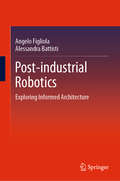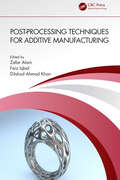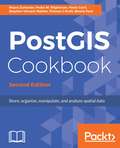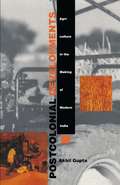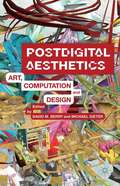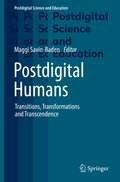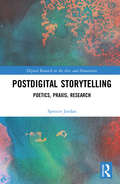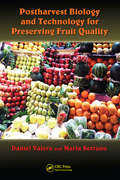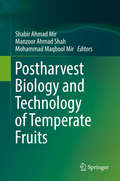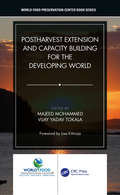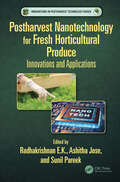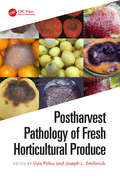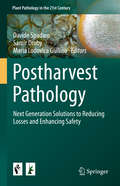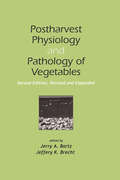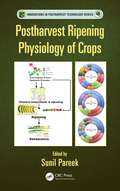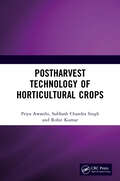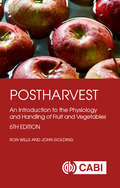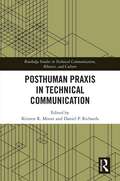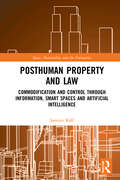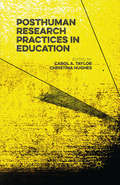- Table View
- List View
Post-industrial Robotics: Exploring Informed Architecture (Springerbriefs In Architectural Design And Technology Ser.)
by Angelo Figliola Alessandra BattistiThis book highlights the concept of informed architecture as an alternative to performance-based approaches. Starting with an analysis of the state of art, the book defines an operative methodology in which performative parameters lead to the generation of the shape becoming the design’s input, rather than being mere quantitative parameters. It then uses case studies to investigate the methodology. Lastly, the book discusses a novel way of conceiving and using the manufacturing tool, which is the basis for the definition of informed architectures in relation to data usage and the optimization process.
Post-processing Techniques for Additive Manufacturing
by Zafar Alam Faiz Iqbal Dilshad Ahmad KhanThis text defines and covers different themes of post-processing techniques based on mechanical, chemical/electrochemical, and thermal energy. It will serve as an ideal reference text for senior undergraduate and graduate students in diverse engineering fields including manufacturing, industrial, aerospace, and mechanical. This book: covers the fundamentals and advancements in the post-processing techniques for additive manufacturing; explores methods/techniques for post-processing different types of materials used in additive manufacturing processes; gives insight into the process selection criteria for post-processing of additive manufactured products made from different types of materials; discusses hybrid processes used for post-processing of additive manufacturing parts; and highlights post-processing techniques for properties enhancement. The primary aim of the book is to give the readers a well-informed layout of the different post-processing techniques that range from employing mechanical energy to chemical, electrochemical, and thermal energy to perform the intended task.
PostGIS Cookbook, Second Edition: Store, Organize, Manipulate, And Analyze Spatial Data, 2nd Edition
by Mayra ZurbaránPostGIS is a spatial database that integrates the advanced storage and analysis of vector and raster data, and is remarkably flexible and powerful. PostGIS provides support for geographic objects to the PostgreSQL object-relational database and is currently the most popular open source spatial databases. If you want to explore the complete range of PostGIS techniques and expose related extensions, then this book is for you. This book is a comprehensive guide to PostGIS tools and concepts which are required to manage, manipulate, and analyze spatial data in PostGIS. It covers key spatial data manipulation tasks, explaining not only how each task is performed, but also why. It provides practical guidance allowing you to safely take advantage of the advanced technology in PostGIS in order to simplify your spatial database administration tasks. Furthermore, you will learn to take advantage of basic and advanced vector, raster, and routing approaches along with the concepts of data maintenance, optimization, and performance, and will help you to integrate these into a large ecosystem of desktop and web tools. By the end, you will be armed with all the tools and instructions you need to both manage the spatial database system and make better decisions as your project's requirements evolve.
Postbiotics (Methods and Protocols in Food Science)
by Dhanasekaran DharumaduraiThis volume details preparations, separations, identification, analysis of postbiotics types and mechanism, uses of postbiotics in health, pharma, aquacultures, and the food industry. Divided into five sections chapters provide methods on antimicrobials, antibiofilm, anti-inflammatory, antiallergies, antiobesity, meurotransmitter activity, dietary supplementation and Immunomodulatory activity of postbiotics, postbiotics as biopreservatives , and as well as food packing material. . Written in the format of the Methods and Protocols in Food Science series, chapters list necessary materials and methods for readily reproducible protocols. Authoritative and cutting-edge, Postbiotics aims to be a foundation for future studies and to be a source of inspiration for new investigations in the field.
Postcolonial Developments: Agriculture in the Making of Modern India
by Akhil GuptaThis definitive study brings together recent critiques of development and work in postcolonial studies to explore what the postcolonial condition has meant to rural people in the Third World. Focusing on local-level agricultural practices in India since the "green revolution" of the 1960s, Akhil Gupta challenges the dichotomy of "developed" and "underdeveloped," as well as the notion of a monolithic postcolonial condition. In so doing, he advances discussions of modernity in the Third World and offers a new model for future ethnographic scholarship. Based on fieldwork done in the village of Alipur in rural north India from the early 1980s through the 1990s, Postcolonial Developments examines development itself as a post-World War II sociopolitical ideological formation, critiques related policies, and explores the various uses of the concept of the "indigenous" in several discursive contexts. Gupta begins with an analysis of the connections and conflicts between the world food economy, transnational capital, and technological innovations in wheat production. He then examines narratives of village politics in Alipur to show how certain discourses influenced governmental policies on the green revolution. Drawing links between village life, national trends, and global forces, Gupta concludes with a discussion of the implications of environmentalism as exemplified by the Rio Earth Summit and an examination of how global environmental treaties may detrimentally affect the lives of subaltern peoples. With a series of subtle observations on rural politics, nationalism, gender, modernization, and difference, this innovative study capitalizes on many different disciplines: anthropology, sociology, comparative politics, cultural geography, ecology, political science, agricultural economics, and history.
Postdigital Aesthetics
by David M. Berry Michael DieterPostdigital Aesthetics presents a constellation of contributors who seek to unpack, explore and critically reflect on the questions raised by the notion of the postdigital and its relation to our computational everyday lives. Through a number of interventions, each chapter subjects the concept and ideas that surround our ideas of an aesthetic of the postdigital to critical examination to understand the new asterism of material digital culture in the twenty-first century. From Minecraft to post-internet art, each contributor offers an original perspective on network culture and its distinctive aesthetics and politics, and the relations between art, computation and design.
Postdigital Humans: Transitions, Transformations and Transcendence (Postdigital Science and Education)
by Maggi Savin-BadenThis book explores approaches to developing and using postdigital humans and the impact they are having on a postdigital world. It presents current research and practices at a time when education is changing rapidly with digital, technological advances. In particular, it outlines the major challenges faced by today’s employers, developers, teachers, researchers, priests and philosophers. The book examines conceptions of postdigital humans and studies the issue in connection with ethics and employment, as well as from perspectives such as philosophy and religion.
Postdigital Storytelling: Poetics, Praxis, Research (Digital Research in the Arts and Humanities)
by Spencer JordanPostdigital Storytelling offers a groundbreaking re-evaluation of one of the most dynamic and innovative areas of creativity today: digital storytelling. Central to this reassessment is the emergence of metamodernism as our dominant cultural condition. This volume argues that metamodernism has brought with it a new kind of creative modality in which the divide between the digital and non-digital is no longer binary and oppositional. Jordan explores the emerging poetics of this inherently transmedial and hybridic postdigital condition through a detailed analysis of hypertextual, locative mobile and collaborative storytelling. With a focus on twenty-first century storytelling, including print-based and nondigital art forms, the book ultimately widens our understanding of the modes and forms of metamodernist creativity. Postdigital Storytelling is of value to anyone engaged in creative writing within the arts and humanities. This includes scholars, students and practitioners of both physical and digital texts as well as those engaged in interdisciplinary practice-based research in which storytelling remains a primary approach.
Postharvest Biology and Technology for Preserving Fruit Quality
by Daniel Valero Maria SerranoInterest in the postharvest behavior of fruits and vegetables has a history as long as mankind's. Once we moved past mere survival, the goal of postharvest preservation research became learning how to balance consumer satisfaction with quantity and quality while also preserving nutritional quality. A comprehensive overview of new postharvest techno
Postharvest Biology and Technology of Temperate Fruits
by Manzoor Ahmad Shah Shabir Ahmad Mir Mohammad Maqbool MirThis edited volume provides insight into temperate fruits, with an emphasis on postharvest physiology, storage, packaging and technologies for maintaining fruit quality. Chapters are devoted to individual fruits and focus on fundamental issues such as methods for maintaining or enhancing quality, minimizing postharvest losses, and recommended technologies to boost demand. Contributions come from experts in the field, making this a key reference for all aspects of postharvest management of temperate fruits.The volume is unique in its focus on the biodiversity, nutritional and health benefits, and postharvest technologies for shelf life enhancement of temperate fruits. Contributing authors address the postharvest biology and technology of individual temperate fruits such as plum, cherry, peach, apricot, apple, pear, quince, loquat, kiwi, persimmon and berries. There has been tremendous growth in the research and development of new techniques to maintain the quality of temperate fruits from farm to table. Contributions from experts in the field cover these recent advances, providing up-to-date and relevant information for researchers, postharvest/fruit technologists, food scientists, postgraduate students, and others working in the industry.
Postharvest Extension and Capacity Building for the Developing World (World Food Preservation Center Book Series)
by Majeed Mohammed and Vijay Yadav TokalaIt is estimated that around 1.3 billion tons per year of food produced for human consumption, which is about one-third of all food produced, is either lost or wasted globally. Reduction of the postharvest losses is being considered as one of the sustainable ways to ensure world food security. Postharvest Extension and Capacity Building for the Developing World provides information on postharvest extension/outreach programs, capacity building, and practical methodologies for postharvest extension professionals and food science teachers, food processing trainers, and outreach specialists who work in the field. The book provides information on training of postharvest trainers, food loss assessment methods, capacity building in universities and agro-industry, distance education methods, models for cost effective postharvest/food processing extension work, success stories, and lessons learned from past projects and programs. The book is divided into four sections. Section I explains postharvest loss assessments methods, Section II is on capacity building, and Sections III and IV focus on training and postharvest extension models. Food loss assessment methodologies are highlighted from several high-profile institutions and it is envisioned that researchers and postharvest extension personnel will benefit from the development and field testing of a hybrid methodology, incorporating the strengths and utilizing the best practices from each of the methodologies in current use. Chapters cover postharvest extension work and capacity building in a wide range of regions.
Postharvest Handling and Diseases of Horticultural Produce
by Dinesh SinghPostharvest Handling and Diseases of Horticultural Produce describes all the postharvest techniques, handling, pre-cooling, postharvest treatment, edible coating and storage of the horticultural produce available to handle perishable horticultural food commodities, covering the areas of horticulture, agricultural process engineering, postharvest technology, plant pathology and microbiology. Postharvest diseases of major fruits and vegetables, with their causal agents, are described. The integrative strategies for management of postharvest diseases include effectively inhibiting the growth of pathogens, enhancing the resistance of hosts and improving environmental conditions, with results that are favourable to the host and unfavourable to the pathogen growth including biotechnological approaches. Adopting a thematic style, chapters are organized by type of treatment, with sections devoted to postharvest risk factors and their amelioration. The chapters are written by experts in the fields of plant pathology, horticulture, food science etc., and core insights into identifying and utilizing appropriate postharvest options for minimizing postharvest losses and enhancing benefits to end-users are provided. Features Presents the most recent developments in the field of postharvest handling technologies and diseases in a single volume Includes postharvest diseases of cut flowers, fruits, vegetables and tuber crops. Appropriate for students, researchers and professionals Written by experts and can be used as a reference resource
Postharvest Management of Horticultural Crops: Practices for Quality Preservation (Postharvest Biology and Technology)
by Mohammed Wasim Siddiqui; Asgar AliThis book presents several pre- and postharvest strategies that have been developed to modify these physiological activities, resulting in increased shelf life. The book also discusses the best technologies that positively influence quality attributes of the produce, including senescenal changes and, afterwards, the consumers’ decision to purchase the product in the marketplace. With contributions from experts with experience in both developed and developing regions, the book includes chapters covering thorough discussions on postharvest management strategies of fresh horticultural commodities.
Postharvest Nanotechnology for Fresh Horticultural Produce: Innovations and Applications (Innovations in Postharvest Technology Series)
by Sunil Pareek Radhakrishnan E. K. Ashitha JoseFood scarcity and insecurity is an alarming issue throughout the world. Postharvest loss due to both mechanical damage and microbial spoilage significantly influences the shelf life and hence the availability of agricultural produce. Once initiated, the microbial spoilage can make bulk quantity of a given agricultural product unacceptable for human consumption, and several methods have already been used to try to manage this. Considering the limited success of the available methods, there is increasing interest in exploring nanotechnological methods. These methods are being considered for both the development of various platforms for antimicrobial/barrier packaging applications that minimize the contact of agricultural produce with the external environment, and also for design sensors to ensure food safety and quality. The impact of various nano-systems developed through material engineering on the shelf-life enhancement and storage of fresh horticultural produce will have revolutionary effects on post-harvest management in the coming years. Hence, Postharvest Nanotechnology for Fresh Horticultural Produce has been edited to advance understanding of material development, intelligent selection of nanomaterials to ensure the nontoxic nature, and future perspectives of nanotechnology on postharvest produce. This includes various types of nanoparticles exploited for the postharvest management, their mechanism of action, varied applications and material engineering, along with natural products including essential oils and plant bioactives, modelling of various tailor-made materials to meet the required properties of the packed food, advancements in the nanotechnological applications for the minimally processed food, and the toxicity concerns. Key Features: · Describes advances in nanotechnology for postharvest management · Includes extensive details on the applications of material engineering for post-harvest applications using nanotechnology and future aspects · Provides extensive data on the types of nanomaterials used and the fabrication methods employed for the design of tailor-made products for the post-harvest management This book reviews the current scientific advancements and future prospects of the nanotechnological interventions in meeting the quality and quantity standards of the horticultural produce and minimally processed food and will be a valuable reference for beginners, researchers, subject experts, and industrialists.
Postharvest Pathology of Fresh Horticultural Produce
by Lluis Palou Joseph L. SmilanickOptimal distribution of fresh horticultural products entails prolonging their freshness and nutritional quality as long as possible after harvest. A major limitation to their marketing is decay after harvest, which is caused primarily by fungal pathogens. Postharvest Pathology of Fresh Horticultural Produce provides a comprehensive resource of information about the biology and control of postharvest diseases of many fresh horticultural products, citing sources from appropriate literature of any age, rather than only the most recent. The etiology and symptoms of postharvest diseases and the biology of postharvest pathogens are reviewed by leading experts, who are familiar with many of world’s most popular fresh fruits and vegetables and the diseases that affect them. Key aspects related to infection and epidemiology, methods to minimize postharvest decay losses, including use of conventional fungicides and alternative management strategies, harvest and handling practices, and other aspects are described for the most significant temperate, subtropical, and tropical fruits as well as fruit-like vegetables and leafy vegetables. Features: Provides comprehensive academic and practical reviews of postharvest diseases of fresh fruits and vegetables Discusses the economic importance, etiology, and epidemiology of the most significant postharvest diseases Includes quality color plates that allow the practical identification of disease symptoms Explains practical postharvest disease management actions, including the use of conventional fungicides and alternatives to their use The authors summarize a massive quantity of published information, and often apply their own considerable practical experience to identify and interpret the most significant information. This book is a valuable and comprehensive resource for industry professionals, academics, educators, students, consultants, pest control advisors, regulatory personnel, and others interested in this subject.
Postharvest Pathology: Next Generation Solutions to Reducing Losses and Enhancing Safety (Plant Pathology in the 21st Century #11)
by Maria Lodovica Gullino Davide Spadaro Samir DrobyThe book will address selected topics in postharvest pathology aiming at highlighting recent development in the science, technology and control strategies of postharvest diseases to reduce losses and enhance safety of harvested agricultural products. Topics will include: 1) Introduction: Perspectives and challenges in postharvest pathology 2) Elucidating host-pathogen interactions 3) Next generation technologies for management and detection of postharvest pathogens 4) Food safety in postharvest pathology 5) Alternative postharvest diseases control strategies 6) Chemical control of postharvest diseases
Postharvest Physiological Disorders in Fruits and Vegetables (Innovations in Postharvest Technology Series)
by Sergio Tonetto de Freitas Sunil PareekThis book, chock full of color illustrations, addresses the main postharvest physiological disorders studied in fruits and vegetables. For a wide variety of fruits and vegetables, Postharvest Physiological Disorders in Fruits and Vegetables describes visual symptoms, triggering and inhibiting mechanisms, and approaches to predict and control these disorders after harvest. Color photographs illustrate the disorders, important factors, physiology, and management. The book includes a detailed description of the visual symptoms, triggering and inhibiting mechanisms, and possible approaches to predict and control physiological disorders. The mechanisms triggering and inhibiting the disorders are discussed in detail in each chapter, based on recent studies, which can help readers better understand the factors regulating each disorder. The description of possible approaches to predict and control each disorder can help growers, shippers, wholesalers, and retailers to determine the best management practices to reduce disorder incidence and crop losses. Features: Presents visual symptoms of postharvest physiological disorders that will help readers to precisely identify the disorders in fruits and vegetables Details mechanisms triggering and inhibiting the postharvest disorders Explains possible approaches to predict and control these disorders Suggests the best postharvest management approaches for each crop Although there are many scientific publications on postharvest physiological disorders, there are no recent reviews or books putting together the most recent information about the mechanisms regulating, as well as about the possible approaches to predict and control these disorders.
Postharvest Physiology and Pathology of Vegetables
by Jeffrey K. Brecht Jerry A. BartzFocusing exclusively on postharvest vegetable studies, this book covers advances in biochemistry, plant physiology, and molecular physiology to maximize vegetable quality. The book reviews the principles of harvest and storage; factors affecting postharvest physiology, calcium nutrition and irrigation control; product quality changes during handling and storage; technologies to improve quality; spoilage factors and biocontrol methods; and storage characteristics of produce by category. It covers changes in sensory quality such as color, texture, and flavor after harvest and how biotechnology is being used to improve postharvest quality.
Postharvest Ripening Physiology of Crops (Innovations in Postharvest Technology Series)
by Sunil PareekPostharvest Ripening Physiology of Crops is a comprehensive interdisciplinary reference source for the various aspects of fruit ripening and postharvest behavior. It focuses on the postharvest physiology, biochemistry, and molecular biology of ripening and provides an overview of fruits and vegetables, including chapters on the postharvest quality
Postharvest Technology and Food Process Engineering
by Amalendu Chakraverty R. Paul SinghCereals, legumes, oilseeds, fruits, and vegetables are the most important food crops in the world, with cereal grains contributing the bulk of food calories and proteins worldwide. Generally, the supply of grains and other food can be enhanced by increasing production and by reducing postharvest losses. While food production has increased significa
Postharvest Technology of Horticultural Crops
by Rohit Kumar Subhash Chandra Singh Priya AwasthiThis book is an informative introduction to the post-harvest technology of horticultural crops, and their conservation and management. The different post-harvest handling operations including storage aspects are also covered. Innovative processing technologies like high-pressure processing, irradiation, cold plasma technique and ohmic heating are also discussed in the book.
Postharvest: An Introduction to the Physiology and Handling of Fruit and Vegetables
by Ron Wills John GoldingCompletely updated, this broad-based introductory level textbook covers the key concepts and practical technologies to slow the deterioration of harvested produce, including handling, packaging, transport, temperature management and the control of pests and diseases. The book retains the high quality color section and the content has been revised to reflect up-to-date information on the key issues of effective postharvest handling. New to the sixth edition: - Discussion of issues important to consumers and the impact of trends in convenience marketing on the quality of fresh-cut produce - Coverage of sustainability in terms of both energy used by technologies and non-synthetic disease and pest control systems - Greater consideration given to pre-harvest factors that influence quality - Additional information about the health benefits of plant antioxidant properties and a discussion of "superfoods. " This new edition is an invaluable resource for students of horticulture, plant physiology and food science, and industry personnel involved with the transportation, warehousing, marketing and retailing of fresh produce.
Posthuman Praxis in Technical Communication (Routledge Studies in Technical Communication, Rhetoric, and Culture)
by Kristen R. Moore Daniel P. RichardsThis collection, aimed at scholars, teachers, and practitioners in technical communication, focuses on the praxis-based connections between technical communication and theoretical movements that have emerged in the past several decades, namely new materialism and posthumanism. It provides a much needed link between contemporary theoretical discussions about new materialisms and posthumanism and the practical, everyday work of technical communicators. The collection insists that where some theoretical perspectives fall flat for practitioners, posthumanism and new materialisms have the potential to enable more effective and comprehensive practices, methodologies, and pedagogies.
Posthuman Property and Law: Commodification and Control through Information, Smart Spaces and Artificial Intelligence
by Jannice KällThis book analyses the phenomenon of digitally mediated property and considers how it problematises the boundary between human and nonhuman actors. The book addresses the increasingly porous border between personhood and property in digitized settings and considers how the increased commodification of knowledge makes visible a rupture in the liberal concept of the property owning, free, person. Engaging with the latest work in posthumanist and new materialist theory, it shows, how property as a concept as well as a means for control, changes fundamentally under advanced capitalism. Such change is exemplified by the way in which data, as an object of commodification, is extracted from human activities yet is also directly used to affectively control – or nudge – humans. Taking up a range of human engagements with digital platforms and coded architectures, as well as the circulation of affects through practices of artificial intelligence that are employed to shape behaviour, the book argues that property now needs to be understood according to an ecology of human as well as nonhuman actors. The idea of posthuman property, then, offers both a means to critique property control through digital technologies, as well as to move beyond the notion of the self-owning, object-owning, human. Engaging the most challenging contemporary technological developments, this book will appeal to researchers in the areas of Law and Technology, Legal Theory, Intellectual Property Law, Legal Philosophy, Sociology of Law, Sociology, and Media Studies.
Posthuman Research Practices in Education
by Carol A. Taylor Christina HughesHow do we include and develop understandings of those beyond-the-human aspects of the world in social research? Through fifteen contributions from leading international thinkers, this book provides original approaches to posthumanist research practices in education. It responds to questions which consider the effect and reach of posthuman research.
